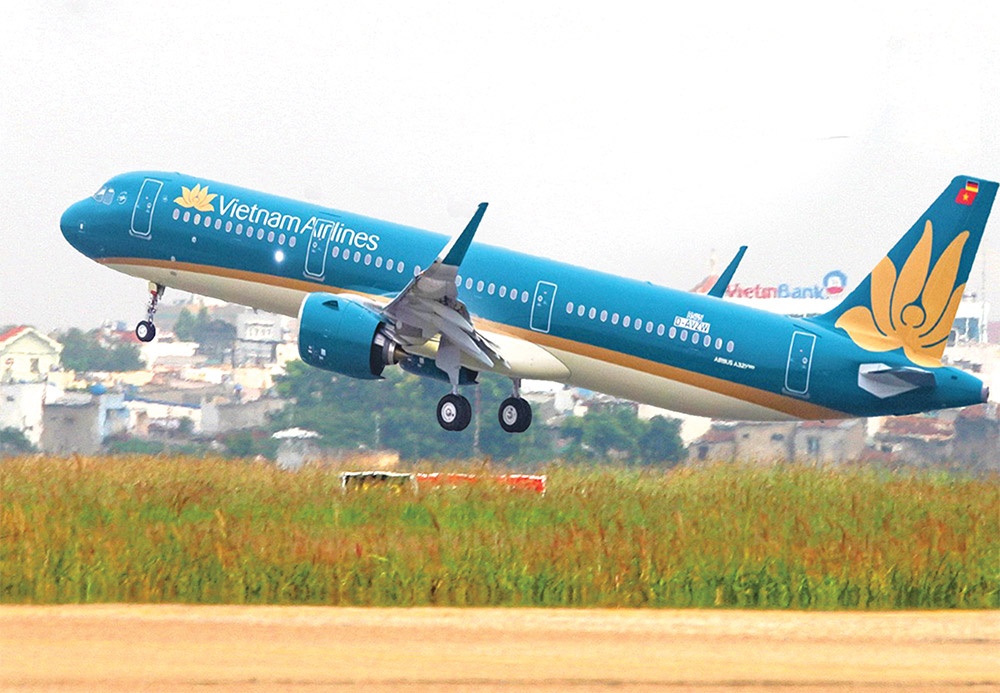Pivotal year for top transport entities
 |
| Vietnam Airlines is restructuring after an exceedingly difficult ride through the pandemic era, photo Duc Thanh |
Digital transformation is one of the targets that Airports Corporation of Vietnam (ACV) and national flag carrier Vietnam Airlines are targeting following the signing of a 4-year strategic cooperation agreement in early January.
The two sides will coordinate to research and develop new products and services in accordance with the trends of the global aviation industry, and will also cooperate extensively in IT and digital transformation.
Dang Ngoc Hoa, chairman of the board of Vietnam Airlines said, “The agreement is a new step in the sustainable cooperation between the two sides, and will promote the strengths and potential of both Vietnam Airlines and ACV.”
In 2024, the corporation will continue to focus on infrastructure investment. It has prepared investment procedures for a number of other projects, including terminal T2 of Cat Bi International Airport and passenger terminal T2 of Dong Hoi Airport.
ACV aims to welcome 118 million passengers this year, an increase of 3.3 per cent compared to 2023, of which 39 million will be international visitors, an on-year increase of 16.8 per cent. Parcel goods will hit over 1.33 million tons, up 8.5 per cent.
These goals are built based on the growth momentum in 2023 when ACV saw a recovery amid complicated developments. Specifically, total revenues reached $845.15 million, up 26 per cent on-year, while pre-tax profit reached $364.55 million, an on-year increase of 14 per cent.
The corporation, which operates 22 airports in Vietnam, saw the total number of passengers reach 113.5 million last year, up 15 per cent on-year, of which international passengers were 32.6 million passengers, up 173 per cent. Total parcel cargo throughput reached over 1.2 million tons.
Brand new ventures
Investment in aviation transport infrastructure was a highlight for the country in 2023. Many projects were completed, or started, contributing to the country’s socioeconomic growth.
ACV kicked off two important sections for Long Thanh International Airport, and commenced the bidding package to build and install equipment for passenger terminal T3 at Tan Son Nhat International Airport. It also put into operation terminal T2 at Phu Bai International Airport, and the Dien Bien Airport expansion.
Similarly, Vietnam Airlines is now paying special attention to implementing a restructuring project aiming at balancing revenue and expenditure from this year.
In the 2021-2025 restructuring, current divestment solutions are key to supplementing cash flow to ensure solvency payment of debts and loans. Along with these, the airline will restructure its corporate governance and focus on digital transformation. It will also focus on adding international and domestic routes after Bamboo Airways’ reduction.
Tran Thanh Hien, chief accountant of Vietnam Airlines said, “It is expected that after a short time, Vietnam Airlines will balance its finances, overcome the consequences of the pandemic, and bring its financial status to safety. We will not need long to make Vietnam Airlines profitable.”
Last year remained tough for the carrier, although it recovered its operations and conducted 130,000 flights, opened four new international routes, and transported over 21 million passengers, equal to 92 per cent compared to 2019.
Its consolidated revenue rose nearly 28 per cent on-year to about $3.88 billion, while it lost $256.54 million in before-tax consolidated profit, compared to a loss of $42.19 million in 2022.
However, the average fuel price in 2023 reached $105.4 per barrel, making fuel costs increase by an estimate by $248.94 million compared to 2019.
According to Dinh Viet Thang, director of the Civil Aviation Authority of Vietnam, in 2023, the domestic market recovered and grew, while the international market is on the road to recovery.
“Vietnam’s aviation market is aligned with the trends of the Asia-Pacific market and will completely recover by the end of 2024,” he said. “The market is forecast to welcome 84.2 million passengers in 2024, an increase of 15 per cent compared to 2023. Total freight demand will reach 1.16 million tons, an increase of 8.5 per cent on-year.”
Advocating for transformation
Elsewhere, shipping giant Vietnam Maritime Corporation (VIMC) and Vietnam Railways (VNR) are also focusing on operational restructuring and seeking new ways to achieve annual targets.
Nguyen Canh Tinh, CEO of VIMC, said that it would continue to maintain and expand its markets and customer regions, while continuing to promote the restructuring of its businesses, finances, and shipping fleet; implementing an effective cost management programme to improve productivity, efficiency, and competitiveness.
“VIMC will also focus on infrastructure investment with key projects such as Lach Huyen wharfs 3 and 4, Can Gio International Transshipment Port, and Lien Chieu Port. It will also expand its seaport, shipping, and logistics ecosystem by investing in infrastructure initiatives, inland container depots, and warehouses, as well as by bringing VIMC Container JSC into operation,” he added.
VIMC also advocates for the green transformation by developing a new-generation shipping fleet and building a modern seaport system that meets regulations and standards for sustainable development and growth.
In 2024, VIMC aims to make total revenues of $748.5 million, and a profit of $91.6 million, even though the dry bulk market will not witness positive changes in 2024 due to high inflation and the Russia-Ukraine conflict. The container shipping market is also expected to continue to face difficulties.
Last year, the company reported that it made a total revenue of $758.2 million, up 0.3 per cent on-year, while its total profit hit $87.8 million. This result is attributed to a number of positive actions, including the development of 12 more service routes to its subsidiary ports, organising marketing programmes to boost ties with clients, shippers, and customers, organising bidding to provide chain services for big customers, and expanding into new international markets.
For VNR, progress is now more positive thanks to the government’s attention. Following the Prime Minister’s latest request to ministries and agencies at VNR’s meeting on January 9 to improve institutions to draw in more development resources for the railway industry, the Ministry of Planning and Investment last week issued a decision to tackle such tasks.
Accordingly, the ministry will chair discussions on the amendment of the Law on Public-Private Partnership Investment before 2026; review and adjust regional planning in line with the railway network planning towards 2030; and chair the development of cooperation plans with foreign sponsors to mobilise preferential loans to invest in the national railway network.
In addition, it will work with other ministries, including the Ministry of Transport, on amendment of the Law on Railways 2017, and proposing the government and the National Assembly to allow the pilot of a number of specific regulations. These include the ratio of state capital contribution in public-private partnerships, the application of build-transfer contracts, incentives, and appropriate risk sharing to engage investors.
With an on-year increase of 1.7 per cent in consolidated revenue and a profit of $4 million after years of losses, VNR targets that by the end of next year, the parent company’s revenue will grow 4.7 per cent a year, and the pre-tax profit target is $13.79 million in 2023-2025, compared to losses in 2021-2022.
 | The 2024 vision for digital application, digital productivity, and digital growth Vietnam’s digital technology industry has made encouraging steps of development and maturity over the years. |
What the stars mean:
★ Poor ★ ★ Promising ★★★ Good ★★★★ Very good ★★★★★ Exceptional
Related Contents
Latest News
More News
- Global partnerships key to Vietnam’s IFC development (December 26, 2025 | 16:18)
- Vingroup pulls out of bid to invest in North-South high-speed railway (December 26, 2025 | 11:42)
- Strengthening supply chains through trade promotions and customs reform (December 24, 2025 | 14:00)
- PM orders investment model for North–South high-speed rail (December 22, 2025 | 17:43)
- LS Eco Energy to invest in Vietnam rare earth sector (December 22, 2025 | 17:31)
- Government moves to establish International Financial Centre (December 21, 2025 | 21:00)
- Vietnam's IFC to target global investment flows (December 21, 2025 | 18:00)
- Two national hospitals expand capacity with new facilities (December 20, 2025 | 09:00)
- Ha Tinh breaks ground on major Vingroup industrial and energy projects (December 19, 2025 | 18:24)
- EVN launches major power infrastructure projects nationwide (December 19, 2025 | 18:17)

 Tag:
Tag:





















 Mobile Version
Mobile Version